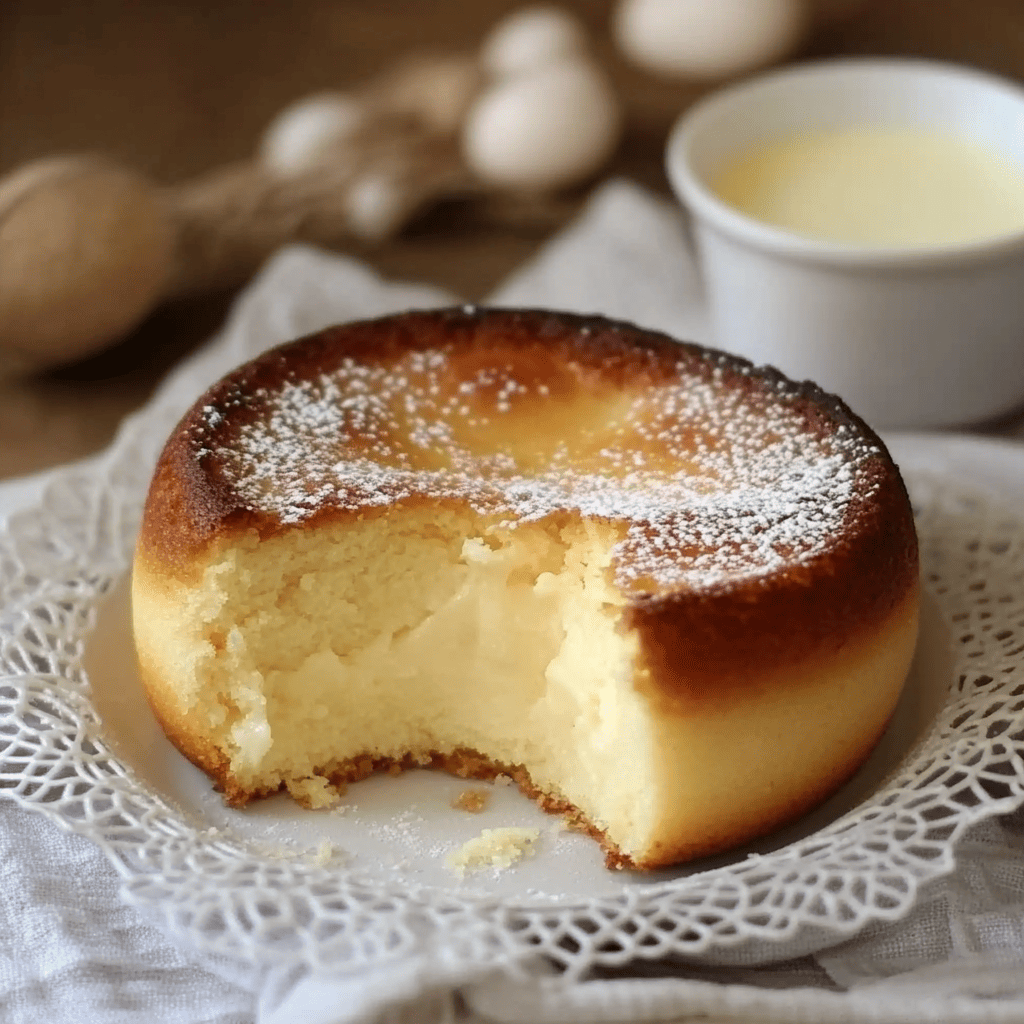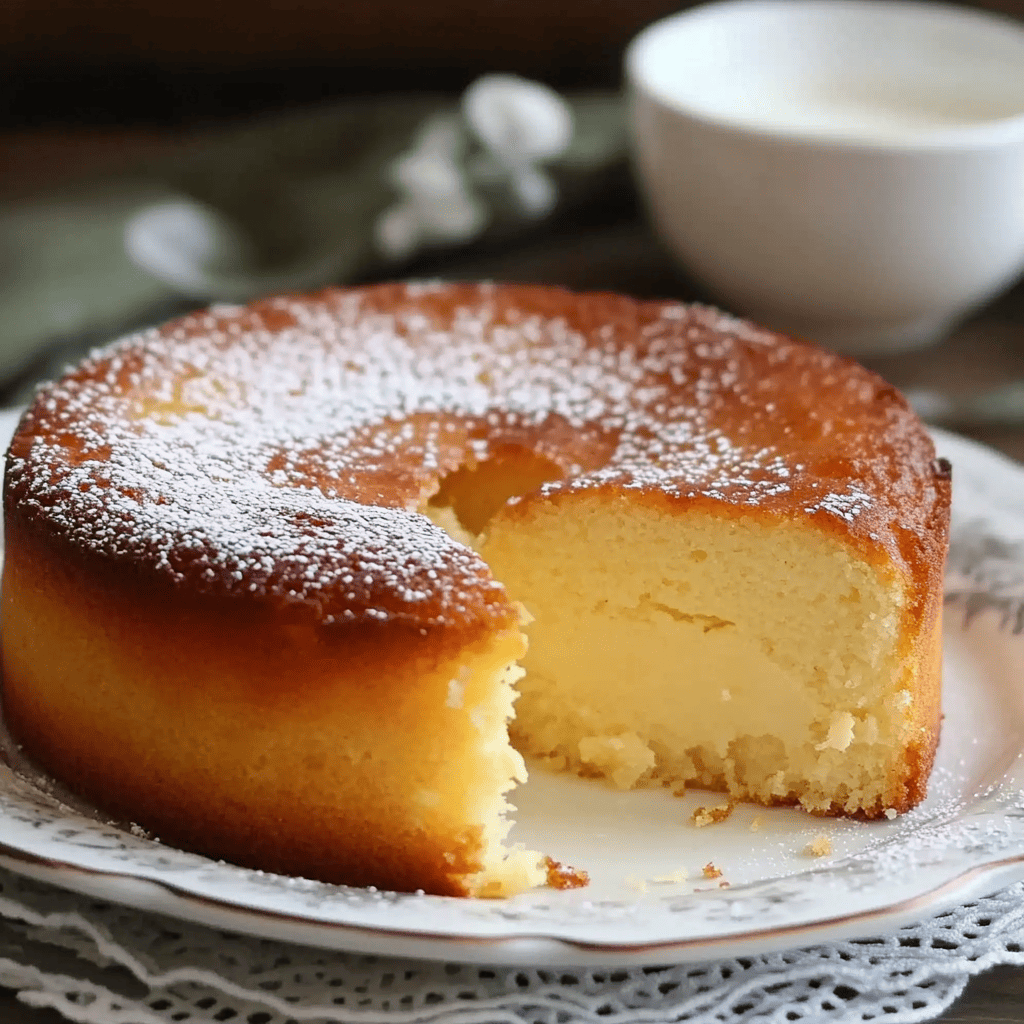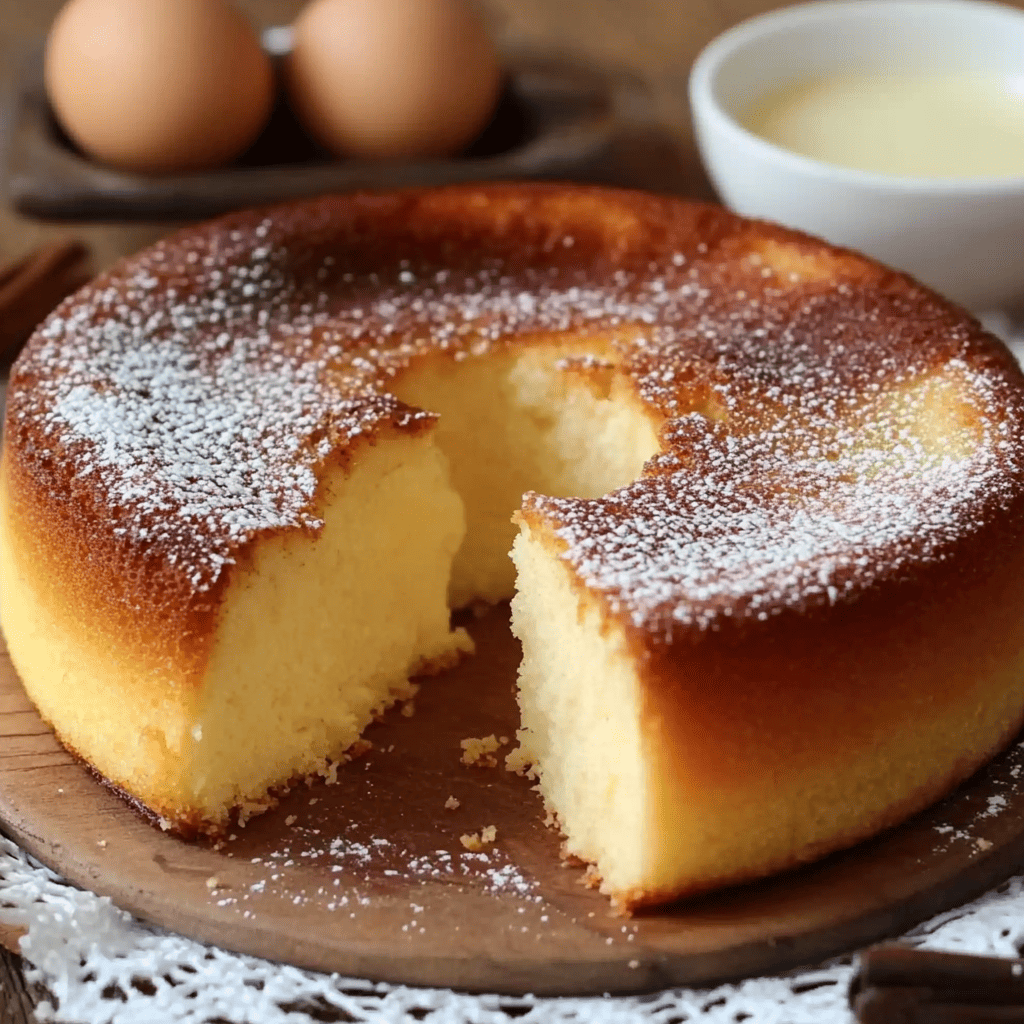Soft and Fluffy Vanilla Cake
This vanilla cake is perfect for any occasion, as its soft and fluffy texture makes it perfect to enjoy alone or with a topping of your choice.
Introduction
Vanilla cake is a classic pastry distinguished by its softness, fluffiness, and delicate flavor. It’s a versatile and delicious option, ideal both for enjoying on its own or as a base for decorated cakes and pastries. Its neutral yet comforting flavor makes it a favorite recipe for birthdays, family gatherings, or simply to accompany a cup of coffee or tea.
The key to a perfect vanilla cake lies in the quality of the ingredients and carefully following the preparation process. Beating the eggs with the sugar until you get an airy mixture is essential for achieving a light texture. Plus, the combination of melted butter and milk adds moisture, making each bite feel tender and delicious.
Another advantage of this recipe is that it doesn’t require complicated techniques or hard-to-find ingredients. With a few pantry staples, anyone, even those without baking experience, can make a delicious cake that’s well-balanced in texture and flavor.
While this cake is exquisite on its own, it can be customized with fillings, toppings, or even fresh fruit and nuts for a special touch. Whether you serve it for a special occasion or as a homemade treat, this soft and fluffy vanilla cake is always a hit. Go ahead and make it and surprise everyone with its incredible flavor!
History of Vanilla Cake
Vanilla cake, in its simplest form, is an evolution of the earliest cakes and biscuits baked in ancient times. Its history dates back to the Egyptian and Roman civilizations, where similar preparations based on flour, eggs, and honey were already made. However, the recipe as we know it today began to take shape in Europe during the Middle Ages, when bakers began experimenting with ingredients like butter and milk to achieve a softer, moister texture.
Vanilla, the star ingredient in this cake, has a fascinating history. Its origins lie in Mesoamerica, where indigenous peoples, especially the Totonacs of what is now Veracruz, Mexico, cultivated and used vanilla long before the arrival of Europeans. With the Spanish conquest in the 16th century, vanilla was brought to Europe, where it became a coveted ingredient for its unique aroma and flavor. At first, it was used exclusively in drinks and desserts for royalty and nobility, but over time, its popularity grew, and it began to be incorporated into pastry recipes like cake.
It was in the 18th and 19th centuries that culinary advances, such as the invention of baking powder and the industrial production of sugar and vanilla, made it possible to create fluffier and more affordable cakes. During this period, vanilla cake became one of the most popular recipes in Europe and North America.
With the advent of modern baking and new baking techniques, this cake has evolved into multiple variations, from lighter versions like sponge cakes to denser, moister pound cakes. Today, vanilla cake remains one of the most beloved and versatile cake options, serving as the base for countless creations, from birthday cakes to elegant gourmet desserts.
Thus, this cake is not only a symbol of simplicity and tradition, but also a reflection of the evolution of baking over the centuries. Today, it remains a favorite around the world, combining the heritage of vanilla with the sweetness and perfect texture of a well-baked treat.

Ingredients:
- 1 cup of sugar
- 1 cup flour (preferably baking or all-purpose, sifted)
- 1 teaspoon baking powder
- ½ cup melted butter
- 3 eggs
- ½ cup of milk
- 1 teaspoon of vanilla essence
- 1 pinch of salt
Preparation:
- Preheat the oven:
- Preheat your oven to 180°C (350°F) so that it is at the right temperature when the dough is ready.
- Grease and flour a 9-inch (23 cm) diameter cake pan. You can also line the bottom with waxed paper to make it easier to remove from the pan.
- Prepare the dry ingredients:
- In a large bowl, sift the flour with the baking powder and a pinch of salt. This will help prevent lumps and give the cake a lighter texture.
- Reserve this mixture for later use.
- Beat the eggs with the sugar:
- In another bowl, place the eggs and sugar. Beat with an electric mixer at medium-high speed for about 5 minutes, until the mixture becomes pale, foamy, and has doubled in volume.
- This step is key to achieving an airy and fluffy cake.
- Add the wet ingredients:
- Add the melted butter and milk to the egg and sugar mixture.
- Also add the vanilla essence.
- Mix gently until the ingredients are well integrated.
- Add the flour to the liquid mixture:
- Gradually add the sifted flour mixture to the previous preparation.
- Use a spatula or wooden spoon to mix with circular motions. This helps maintain the aeration achieved when beating the eggs.
- It is important not to over-beat to prevent the cake from becoming dense.
- Bake:
- Pour the batter into the greased pan and level the surface with the spatula.
- Place in the preheated oven and bake for 25-30 minutes.
- To check if it’s done, insert a toothpick into the center of the cake; if it comes out clean, it’s cooked.
- Cool and unmold:
- Remove the cake from the oven and let it rest in the pan for about 10 minutes.
- Then, transfer it to a wire rack to cool completely before decorating or serving.
Tips for a better result:
Use room temperature ingredients for better blending.
Don’t open the oven during the first 20 minutes of baking to prevent the cake from sinking.
You can add lemon or orange zest for an extra touch of flavor.
Enjoy your delicious vanilla cake!
Tips and tricks for a perfect vanilla cake
If you want to achieve a soft, fluffy, and delicious vanilla cake, here are some helpful tips:
1. Use ingredients at room temperature
- The butter, eggs, and milk should be at room temperature to help them blend better and help achieve a uniform texture in the cake.
- If you forgot to take your eggs out of the refrigerator, you can soak them in warm water for a few minutes to warm them up faster.
2. Sift the dry ingredients
- Sifting the flour together with the baking powder and salt helps prevent lumps and makes the cake have a lighter texture.
- You can also sift the ingredients twice to ensure the mixture is well aerated.
3. Beat the eggs and sugar well
- This step is key to incorporating air into the mixture and achieving a fluffier cake.
- Beat the eggs with the sugar for at least 5 minutes until the mixture becomes clear and foamy.
4. Do not overmix the dough
- Once you add the flour, mix with circular movements and only until the ingredients are incorporated.
- If you overmix the batter after adding the flour, the gluten will develop excessively and the cake will be dense.
5. Use a well-greased mold
- Grease and flour the pan before pouring the batter to prevent the cake from sticking.
- You can also line the bottom with waxed paper to make it easier to remove from the mold.
6. Preheat the oven well
- It is important that the oven is at the correct temperature (180°C or 350°F) before baking the cake.
- If the oven is too cold, the cake won’t rise properly; if it’s too hot, it will brown too quickly on the outside and be raw on the inside.
7. Do not open the oven before time
- Avoid opening the oven door during the first 20 minutes of baking, as sudden temperature changes can cause the cake to sink in the center.
8. Test for doneness with a toothpick
- To make sure the cake is done, insert a toothpick into the center. If it comes out clean, it’s cooked.
- If the toothpick comes out with raw batter, leave the cake in the oven for a few more minutes and test again.
9. Let it cool properly
- After baking, leave the cake in the pan for 10 minutes before removing it from the pan.
- Then place it on a wire rack to cool completely before decorating or cutting.
10. Personalize your cake
- You can add lemon or orange zest to the dough to give it a touch of freshness.
- You can also fill it with cream, jam or chocolate to make it more special.
- If you prefer a healthier version, you can replace some of the sugar with honey or natural sweeteners.
By following these tips, you’ll achieve a perfect vanilla cake every time. Enjoy!

Comprehension questions
- What is the origin of vanilla and how did it get to Europe?
- Why is it important to beat the eggs and sugar well when making a cake?
- What role does baking powder play in the recipe?
- How did advances in 18th and 19th century cooking influence the popularity of vanilla cake?
- Why is it advisable to sift flour before using it in a recipe?
Questions about pastry techniques
- How can you make vanilla cake even fluffier?
- What alternatives to butter can be used in the recipe to make it lighter or healthier?
- What effect does the temperature of the ingredients have on the final texture of the cake?
- What other flavors can be combined with vanilla to give the cake a different touch?
- How to prevent a cake from sinking in the center after baking?
Creative and Personalization Questions
- How would you decorate a vanilla cake for a special occasion?
- What kind of filling do you think would go best with a vanilla cake?
- How would you adapt this recipe to make cupcakes instead of a large cake?
- How could you make a vegan version of this cake without using eggs or butter?
- What changes would you make to the recipe to give it a unique and personal touch?
These questions can help you learn more about the history, technique, and creativity behind vanilla cake!
Texture and flavor:
- Texture: Very fluffy, soft and airy thanks to the beaten eggs and baking powder.
- Flavor: Sweet, delicate, and with the classic comforting aroma of vanilla.
Consumption context:
- Perfect for birthdays, snacks, breakfasts, or as a base for cakes decorated with cream, fruit, or icing.
- It can also be enjoyed alone with a cup of coffee, tea or milk.
Visual appearance:
- Light yellow color with a slightly golden surface.
- Moderate height and uniform cut.
- It can be decorated with powdered sugar, whipped cream, fruit, or vanilla or chocolate coating.
Curiosities:
- It is a basic recipe for classic pastries and serves as a starting point for many other cakes (filled, layers, cupcakes, etc.).
- Sifting the flour is crucial to achieve a lighter texture.
- If you separate and beat the egg whites separately, you can get an even more airy crumb.
Estimated nutritional value (per 1/8 cake serving):
- Calories: 250–280 kcal
- Fat: 12–14 g
- Carbohydrates: 30–35 g
- Sugar: 18–22 g
- Protein: 4–5 g
( Values may vary depending on brands and proportions used. )
Additional benefits and interesting facts:
- Easy to customize: you can add lemon zest, cinnamon, or change the vanilla to almond.
- It can be prepared in a gluten-free version by replacing the flour with a gluten-free mix.
- It is an excellent cake for beginners in baking .

Conclusion
Vanilla cake is one of the most classic and beloved pastry recipes, thanks to its perfect balance of softness, fluffiness, and a delicate yet comforting flavor. Throughout history, this cake has evolved from its origins in ancient pastries to become a fundamental base for countless culinary creations around the world. Its versatility allows it to be enjoyed alone, with fillings and toppings, or as the perfect base for more elaborate cakes.
The key to achieving a perfect vanilla cake lies in the proper use of ingredients and carefully following the preparation process. From properly beating the eggs and sugar to gently folding in the flour, every step influences the cake’s final texture. Furthermore, details such as the temperature of the ingredients, the sifting of the flour, and precise baking control guarantee a successful result.
Beyond its simplicity, this cake offers endless possibilities for customization. You can add flavors like citrus zest, spices like cinnamon, or even substitute certain ingredients to make it healthier or adapt it to special diets. Thanks to these variations, the vanilla cake remains an ideal choice for both beginners and experienced bakers.
Ultimately, baking a good vanilla cake is not only a culinary pleasure, but also an opportunity to share special moments with family and friends. Whether for a celebration or simply to enjoy a homemade dessert, this classic recipe will always be a delicious and timeless choice. Go ahead and bake it and enjoy its unique flavor!

